
Using Theme, Color, and Widgets Using Theme, Color, and Widgets
Once you register as an Amazon Associate, you can immediately begin to use Amazon’s link builder tool to create links to specific products on your Web site. Generating revenue with the Amazon Associates program is all about choosing the right type of ads and links for the right product(s) and placing them in the right place and context. You can also use Amazon’s contextual products, which will place links to products on your site based on what words are on the page. This is a good way to automatically target your readers’ interests. There is also a whole new set of widget links that are available to keep customers on your Web site longer. Amazon is continually changing and adding on to these widgets to keep the customers interested and increase purchases. As a member of the Associates Program, you will have access to Associates Central®, where you will create links, see traffic and earning reports, and find news regarding the latest offerings from Amazon. According to Amazon, the Associates Central allows you to:
- Use the “build links” tool to design and place links to Amazon.
- Keep track of traffic and earnings reports on a daily basis.
- Pay no revenue share.
- Have no ongoing licensing requisites.
- Modify your Web site any time, live.
- Host on your Web site or the hosting account.
- Take advantage of the easy-to-use shopping cart, where buyers add desired products to their cart and only leave your Web site when they are finished shopping and ready for Amazon checkout.
- Market merchandise and categories in the page titles.
- Update Web site templates easily.
- Manage your site pages easily with the HTML editor for customized store content.
The most lucrative approach is for you to feature products that best match your Web site’s theme and the interests of your visitors. For example, if your site is about wine, you might want to promote the latest book about wineries in Italy. Remember the following tips when choosing your products:
- Select products that match your Web site content. Limit your choices by looking on Amazon for specific products, keywords, and categories that match the subject of your Web site. View your results first by product line, then sort by other criteria, such as sales rank or average customer review.
- Think about product cross-merchandising. A large number of your visitors will have an interest in a wide variety of products. You can take advantage of this diversity by marketing items from throughout the varied Amazon catalog and, thus, capture more sales. For instance, if you have been highlighting best-selling exercise equipment on your Web site, consider increasing your sales by featuring additional pertinent products, such as nutritional supplements or workout apparel.
- Search for other items to feature with Amazon’s similarities service. On the detail page of a product that you have already identified as appropriate for your Web site, click on the “Explore Similar Items” link to find additional items. For example, customers who buy kitchen items may also want to buy products for outdoor cooking.
- Review your orders report to determine which products customers buy after visiting your Web site. In order to not lose these sales, you may want to market some of these items directly yourself. Spend time gaining additional information about the best ways to analyze and utilize the report’s information.
- Conduct a trial on selling higher-priced products. Highlighting a range of priced items offers you the opportunity to increase your commissions.
Using the Amazon Visual Links
As noted, Amazon continuously updates its technology and is normally on the forefront of both what occurs on the Web site itself and also behind the scenes. In 2008, the company added a number of new widgets. Although small, they are visually effective and easy-to-use electronic links that give you the opportunity to highlight special items from Amazon on your site, blog, and social networking pages, such as Facebook® and MySpace®. In just a matter of a minute or two, you can add these widgets to you or your visitors’ favorite Amazon products, along with your personal comments about these items. You can also choose from a range of colors and design themes that match the subject of your Web site.
These widgets can highlight music, movies, food, clothing, entertainment, and many other themes that may be of interest to the million visitors going to Web sites that carry Amazon Associates links. In 2007 alone, Amazon Associates created more than 200,000 unique widgets that were displayed more than 800 million times.
Amazon Widgets
The traditional and state-of-the-art Amazon widgets include:
Search
These widgets allow visitors to find and explore products of interest without leaving the Associate’s Web site. Visitors can use the “search box” if you have a lot of products displayed on a page. When a top search engine, such as Google®, Yahoo!®, or Bing® sends someone to a Web site, and that person does not automatically see the expected product, there is a tendency to quickly go on to the next possible site. In the meantime, your sale is lost. If there is a centrally located search box, the visitor is most apt to use it and not leave.
Quick Linker
Users can quickly and easily link to relevant products while writing their blog posts or page content with the use of these custom HTML tags.
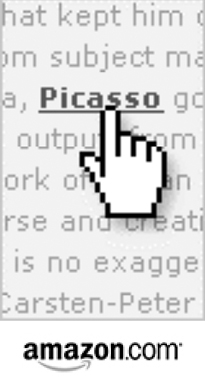
Amazon, Amazon.com and the Amazon.com logo are registered trademarks of Amazon.com, Inc. or its affiliates.
Omakase
Omakase ads and links are one of the latest widgets. They feature products based on page content. According to Amazon, the Japanese word omakase means “leave it up to us.” It is frequently said in Japanese restaurants when the chef uses expertise and cooking knowledge to choose and make the food for a customer without being given any directions. Omakase links are designed to show potential customers products they would most likely buy, which depends on Amazon’s awareness of the Web site and its visitors, and the actual page.
To design omakase links, you will need to change the template and appearance elements, as well as copy the resulting code on your page. Associates now have options for modifying the layout and adapting the ads to match the look and feel of their Web site, coordinating with the site and supporting their brand by selecting the background colors, links, and border colors and also the use of text or images.
You will be able to get into the omakase links area the same way as with any other widgets. Log onto your account and click on “Build Links.” You will see a range of different applications you can use to customize the Web site. Take note that the omakase links have to perform a technical search of your Web site for pertinent copy. Amazon scans the pages and then picks and adds the most appropriate products.
If you have installed technical safety systems on your Web site, this technical search may not be able to be performed. It may also keep link’s features from proper operations. Amazon may then choose not to supply the content to your Web site because it is not possible to do the necessary search. You must make sure that the “privacy information” link is displayed and not obscured when putting on omakase links. Amazon has the right to cancel your Associates Program affiliation if you do not prominently use the privacy information link.
Omakase links uniquely combine information on each Associate’s Web site according to the visitor’s taste, the site’s content, and historical trends to dynamically generate relevant ads that Amazon then serves to your site. With easy-to-use and strong customization options, omakase lets you automatically provide personalized product ads to your Web site visitors that complement online design. Because omakase optimizes on more than just the page itself, Associates may see a range of different products in their links, but they will also find that the links are based on what their visitors would like to buy. Actually, because the goal of omakase is to show the right product to the right person, everyone visiting the site may see different products.
Omakase Links
Their slogan is “Leave it up to us!” These automatically feature ideal products based on Amazon’s unique knowledge about what works for your site, for your users and for the content of your page.
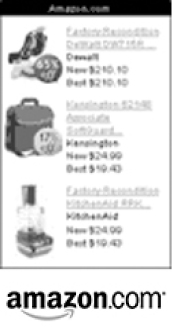
Amazon, Amazon.com and the Amazon.com logo are registered trademarks of Amazon.com, Inc. or its affiliates.
To determine what products to show on your page, omakase uses a number of different techniques. One of these methods involves the omakase system that processes text on your page and finds products from Amazon that relate to the theme. Amazon also uses unique information about the products that have proved successful for the Associate in the past; and, if the person viewing the site is an Amazon customer, the ads can be tailored to that user’s interests. Here are some of the specific options you have:
- Control the branding for the ad, with a choice between showing Amazon as a logo or as text.
- Modify text, borders, and background color and run banners with or without small product images, text, and borders.
- Use the banner size option to determine the dimensions of the ad based on pixel count.
- Automatically see the display size and products in a preview when changes are made.
- Choose whether to display both the Amazon and lowest Marketplace price by third parties or just the one from Amazon, and also if the display will show the amount that the product is being discounted (for those items larger than 10 percent).
- Modify colors of text to highlight the author, artist, or brand name of the product.
- Automatically identify and link relevant phrases within your blog page content to Amazon products, providing new ad inventory and saving you the time from needing to manually create links. You can add the customized links to your pages in minutes. This is a helpful tool if you have a lot of content and not have much time to thoroughly pick and add the most appropriate products.
- Embed the affiliate links as part of your content.
- Choose the best products and display them. The omakase tool can crawl your page, identify the critical keywords, and start displaying appropriate content. At this point, you have a choice between using omakase and/or context links.
Product Previews
Product previews provide a gateway right from your Web site to Amazon. When visitors put their mouse over a text or image preview-enhanced link, a small window pops up with pertinent copy and information regarding the item you are displaying, such as product image, new and used prices, average customer review, and availability. Product previews give visitors the opportunity to see valuable merchandise information without having to travel onto Amazon. At this point, from the product window, users have the option to put the product in their shopping cart or click through to get more information on Amazon’s Web site. Product previews allow you to give your visitors an easy and effortless way to put products in their shopping cart while reading your site’s content. Results from tests find that there are high click-through and conversion rates from those who see a product preview. This is certainly a good choice in conjunction with context links and text links.

Amazon, Amazon.com and the Amazon.com logo are registered trademarks of Amazon.com, Inc. or its affiliates.
Recommended Products
Recommended product widgets are dynamic links where Amazon automatically selects and serves the content. You enter the type of products you want displayed, and Amazon will update them with the best-selling items, based on your stated criteria. Because Amazon automatically updates these links with the latest content, there is less work required on your part to keep your links and banners updated. For ease and flexibility, you can build recommended product links in two different ways — by category and by keyword — each in multiple sizes.
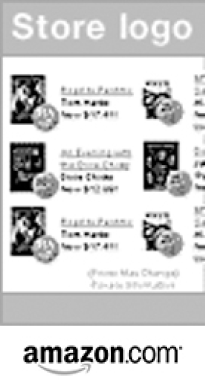
Amazon, Amazon.com and the Amazon.com logo are registered trademarks of Amazon.com, Inc. or its affiliates.
Further, by changing their background, text, and link color, you can customize these links to best fit the design and layout of your site. Based on a product category or keyword, a random set of products are displayed to the visitors. This is appropriate if your Web site content is quite generic but related to a high-level category such as electronics or apparel. Note that there are more targeted options available for other purposes.
Context Links
Context links are similar to the omakase, except they are relevant phrases instead of being content-based. These are directly merged into your content. It is best to use these widgets when there is a lot of user-generated content on your Web site, such as forums, or if you do not have a lot of time to pick specific products and link them on your Web site. Also, one of the positive things about context links, omakase, and recommended product widgets is that even after a couple of months or years, they will continue to display the most up-to-date and available products; you do not have to be concerned about removing any of the specific products that are no longer available.

Context links automatically look for and link contextually relevant phrases within your content to Amazon products. These widgets can be designed as conventional links or in such a way that when a user hovers over them, a small window appears and shows a preview of the appropriate product from Amazon. It is believed that this widget unlocks new ad inventory for Associates by identifying linking opportunities that were not previously noted. It also gives you the opportunity to control the location and number of links on each page. In addition, context links can save you the time required to manually create text links within your content. With context links, merchants can also determine:
- The number of links desired on each page.
- Which part of the page is to be linked.
- What Amazon product categories are linked.
- Whether to match exact product names only.
- Whether to opt for choices of single underline, dashed underline, and double underline link formats to let your Web site visitors know they are context links.
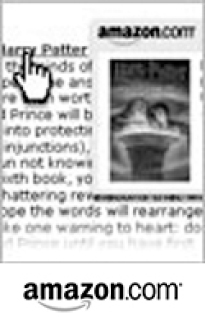
Amazon, Amazon.com and the Amazon.com logo are registered trademarks of Amazon.com, Inc. or its affiliates.
Text Links
Text links give you full control. You can pick a product or keyword of your choice and create a highly targeted page on Amazon. Use this option if you normally review or write about a particular topic and you have identified an excellent product that goes along with it. If the review is specifically about an item itself, then this widget would be ideal. If your content can include an image as well, then go with the product links. Some blog software like WordPress does not allow placing JavaScript™ or iframe tags, and this restricts the links to text links.
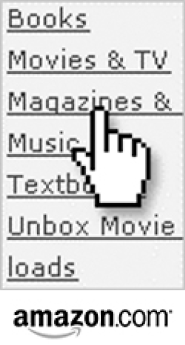
Amazon, Amazon.com and the Amazon.com logo are registered trademarks of Amazon.com, Inc. or its affiliates.
Product Links
Product links are similar to text links. In situations in which you want to target visitors, you have the option of picking the exact product or having the possibility of multiple products with one shown at random. These are appropriate for content that centers on a specific product or topic so that the related product(s) goes along with it.
Carousel
Carousel widgets take your products for a circular spin. With this widget, visitors see products displayed in a 3D carousel or Ferris wheel display. You can suggest certain products to be shown or have the most up-to-date bestsellers and new releases from any Amazon category you want appear.
Briefly, the carousel gives you a unique way to advertise several related Amazon products at the same time. The carousel can be set up vertically or horizontally and at three different dimensions. Also, the products can be chosen automatically by category, or loaded statically up front.
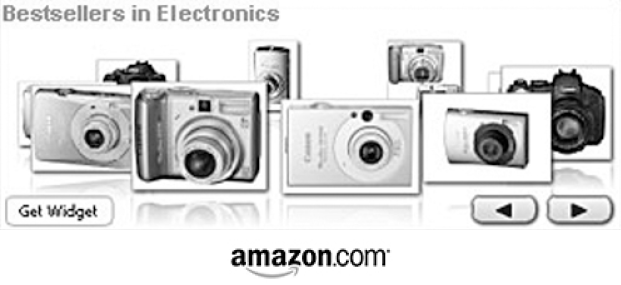
Amazon, Amazon.com and the Amazon.com logo are registered trademarks of Amazon.com, Inc. or its affiliates.
Deals
The deals widget displays the hottest golden deals from Amazon on your Web page, so you can decide which Gold Box deals you want to specifically feature. You can delight your viewers with the “Deal of the Day,” “Lightning Deals,” or “Our Best Deals” from across Amazon.
Deal of the Day: One product or a set of closely related products on sale for that date only.
Our Best Deals: Several different sale items and continuous promotions throughout Amazon.
Lightning Deals: One product matched with a restricted number of bonus savings coupons good for four hours, or the customers have used all coupons.
Quick Picks: Items designed each day particularly for your site, matched with coupons that have a have a limited-time offer for extra savings.
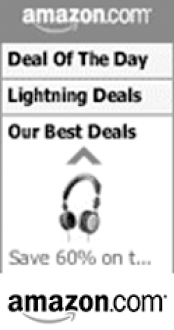
Amazon, Amazon.com and the Amazon.com logo are registered trademarks of Amazon.com, Inc. or its affiliates.
Slideshow
The slideshow widget lets you make a fashion slideshow from the images of products in the Amazon catalog. Pick your favorite books, movies, or CD covers — or show the latest bread maker and food blender. Slideshow widgets let you add your own comments to each image and customize the show to suit your Web page and pictures. Create a slideshow yourself in three quick steps:
1. Choose and sort your product images by entering your terms in the search box. You can search the entire Amazon catalog or only within a selected Amazon store. When you find the products that interest you, click “add product” to have them shown in your widget. You can add comments to your selected products (Make sure you hit the “Save Comments” button), and drag and drop the products to rearrange their order in the list.
2. Hit the “Next step” button and customize your widget’s appearance. Tailor the colors and layout of your link to fit the page design and theme. You can choose the format of your slideshow — simple, gallery, or scrolling — and also the size of the widget. You can also decide which style of slide transition you think looks best.
3. Add the widget to your page. Then, when you are pleased with the final look, hit “Add to My Web page” to get it onto your site.
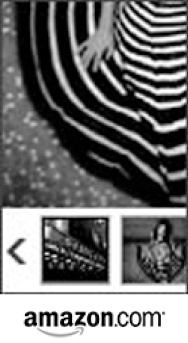
Amazon, Amazon.com and the Amazon.com logo are registered trademarks of Amazon.com, Inc. or its affiliates.
Product Cloud
This widget displays a cluster full of different product titles that relate to your Web site page. The size of the font in the cloud displays its degree of relevance to other products on your site. The larger titles are more closely aligned with your products in your store. When someone hovers a mouse over any title, it will show more information about that specific product. This widget is ideal for those Web sites that have changing content, such as blog pages. It will keep up with your transforming page by automatically showing new titles as your page evolves. To make a product cloud link, merely choose whether the widget should select items from the entire Amazon catalog or only display those from a single Amazon product category. Then, go ahead and design how you want the cloud link to look, and add it to your page. The first time you install this widget, it may take a few minutes before it displays relevant titles because the Amazon system is analyzing your page.
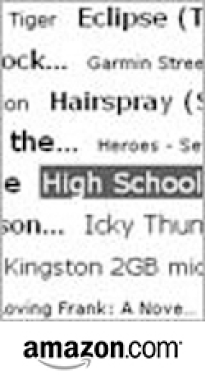
Amazon, Amazon.com and the Amazon.com logo are registered trademarks of Amazon.com, Inc. or its affiliates.
Listmania
Listmania links include any list that you make on Amazon. With a copy, paste, and click, you have a perfect widget for your blog. Here is how it is done: Go to Amazon and copy the address for any Listmania list, such as The New York Times® Book Review Best Sellers. Now, go to the widget gallery and choose Amazon from the list on the left. Select Listmania from the options that appear. Paste the Web address for the Listmania list into the box and click the “GO” button. Your widget will then appear. Click the “Grab This Widget” button to configure the widget and install it on your blog, Web site, or social page. In the configuration screen, you will be able to appropriately adjust the title and layout — you can customize it to perfectly fit your site. This list link has all of the advantages that make widgets so useful: It is easy to install, can be customized to fit your site, updates automatically, and generates revenue via Associate Web sites.
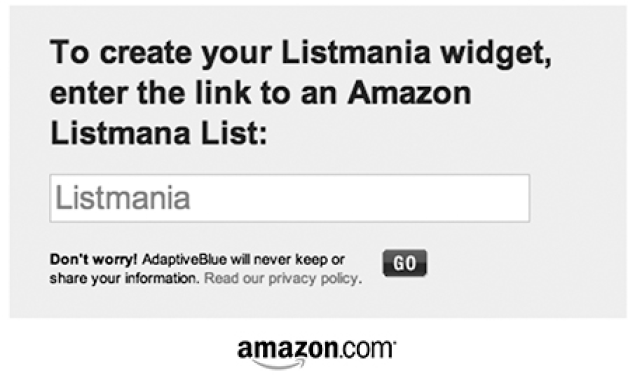
Amazon, Amazon.com and the Amazon.com logo are registered trademarks of Amazon.com, Inc. or its affiliates.
Shopping Cart
Shopping cart links add products directly to your customers’ shopping carts. They make the buying process more convenient and usually convert considerably better than those to product detail pages. You can build add-to-cart links in several ways:
- Enhanced product links: These use Amazon links such as product image, title, price, and an add-to-cart button. All you have to do is copy the code to your site.
- Add-to-cart buttons: These create an add-to-cart button on your Web site for items offered by Amazon by copying and modifying a code. Select from several styles of graphical buttons. You can create similar add-to-cart forms for items offered by third-party sellers using Amazon Web Services.
- Amazon e-commerce service remote shopping cart: This option gives you maximum amount of control and influence over your visitors’ shopping experience. Amazon Web Services can build a remote Amazon shopping cart on your Web site. As visitors browse your site, they will be able to add products to their cart without having to leave the page. When they are finally ready to complete their order, the contents of their cart will be available at Amazon for secure checkout.
Any Page
You may provide a link on your Web site that will link to any particular page on the Amazon site, as long as you have accurately used the special link formats.
MP3 Clips
MP3 clips widget, one of the newest links, lets visitors play samples of songs from Amazon’s huge digital rights management (DRM)-free catalog of more than five million MP3s. You can choose specific songs and albums to display on your Web site, or show the most current bestsellers and latest releases from any music genre you decide on.
This MP3 widget plays 30-second music clips of songs or albums, which you can determine or select from the Amazon list of bestsellers by category. If you do not want to select the songs, Amazon looks at the most recent MP3 buying history of Associates on the widget configuration page. Anyone visiting your sites only has to click on the widget and go to a page to buy the song or album they want. This can be an excellent enhancement for many Associates’ sites. For instance, the Associate can change songs that go along with the season or events. There are a lot of opportunities. The MP3 widget can be configured for sidebars (120×300 or 160×300 pixels) or a larger size for integration with content. After the MP3 widget is built, you will have the choice to get instructions for how to insert it into several social networks and blogs, or to grab the code to and paste into the site.
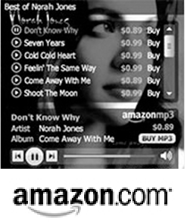
Amazon, Amazon.com and the Amazon.com logo are registered trademarks of Amazon.com, Inc. or its affiliates.
MP3 Widget Reviews:
“The Amazon affiliate program has a new MP3 widget that really sets them apart from other affiliate programs. Fan blogs of different singers and bands are a natural. Movie sites can feature soundtracks. There are a lot of possibilities here,” said Shawn Collins, co-founder of the Affiliate Summit.
Martin Stiksel, www.Last.fm co-founder, said: “When we started offering millions of tracks for free-on-demand streaming earlier this year, we were confident that enabling music fans to listen for free would encourage more music purchasing. In this respect, our relationship with Amazon MP3 was vital – it has the breadth of catalogue and ease of use that’s necessary to give our users the best online music consumption experience. We were extremely pleased to see that our partnership has raised the game for online music, as download and CD purchasing on Last.FM via Amazon increased 119 percent since the free-on-demand launch. This is a great vindication for the pioneering services both our companies provide to music fans.”
Preview Player
The preview player allows you to display and/or publicly perform on your Web site certain video and static media content via data feeds that are made available by Amazon.
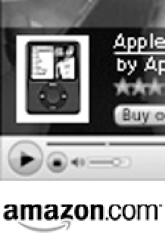
Amazon, Amazon.com and the Amazon.com logo are registered trademarks of Amazon.com, Inc. or its affiliates.
Video
With the video widget links, you can add product links to the videos you already posted on your Web page.
Unbox
Unbox video widgets show studio previews for a tremendous variety of current and classic movies or TV shows, which Unbox video download service offers. This is an area that continues to grow under Amazon’s enterprise.
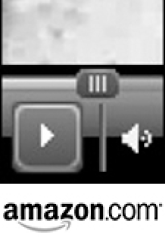
Amazon, Amazon.com and the Amazon.com logo are registered trademarks of Amazon.com, Inc. or its affiliates.
Many Amazon Associates display product links to easily show one item with its image, product name, and up-to-date prices. Because you want numerous repeat visitors to your Web site and do not have much space allotted to these widgets, you have an interesting way to promote and inform at the same time. You can also provide variety by configuring your product links so they randomly display one of several items, rather than displaying only one. With the link customization options, you can specify options like colors. Then, change this HTML to feature other Amazon products that may also be of interest to your Web site visitors. After you paste the changed HTML into your Web site, then each time the page loads, one of the included items will be selected and shown randomly to visitors.
Listed products will be randomly selected for display each time the page loads. Now that there are so many different widgets that are tailored to the individual customers and that work on formats like carousels, videos and MP3s, variety is indeed the spice of life on Amazon Associates’ Web sites.
A Widget by any Other Name
The term widget can be extremely confusing, especially when there are many other words that are used that mean the same thing. Many times, the word “link” is used in place of widget, although they are different. Widgets are also called “buttons” and “gadgets.” According to the tech-savvy blog of Niall Kennedy, the term “widget” is a generic term for a manufactured object that comes from the 1924 Broadway play “Beggar on Horseback.” It is an object that has no value, but is produced for common usage. The main character in the play is torn between his poor living as an artist creating things he enjoys or a job in a factory creating meaningless “widgets.” In economics, the term “widget” is used as a generic object that should not distract from the example at hand. There is the reference to Bob’s Widget Shop instead of Bob’s Donut Shop to focus on the growth numbers, optimum pricing, and additional economic aspects where the details of a donut are irrelevant.
The word “widget” also describes the basic building blocks of a desktop operating system’s graphical user interface. Desktop application developers can take advantage of standard user interface libraries such as a menu, buttons, or display pane. Ralph Swick and Mark Ackerman of Massachusetts Institute of Technology used the word widget for the X Window System in 1988. The term is still used today in the desktop development space to describe building new user interfaces. Amazon launched its own “Amazon Widgets” in 2007. There are now 21 widgets and counting.
(Source: Niall Kennedy, “Weblog,” September 30, 2007)